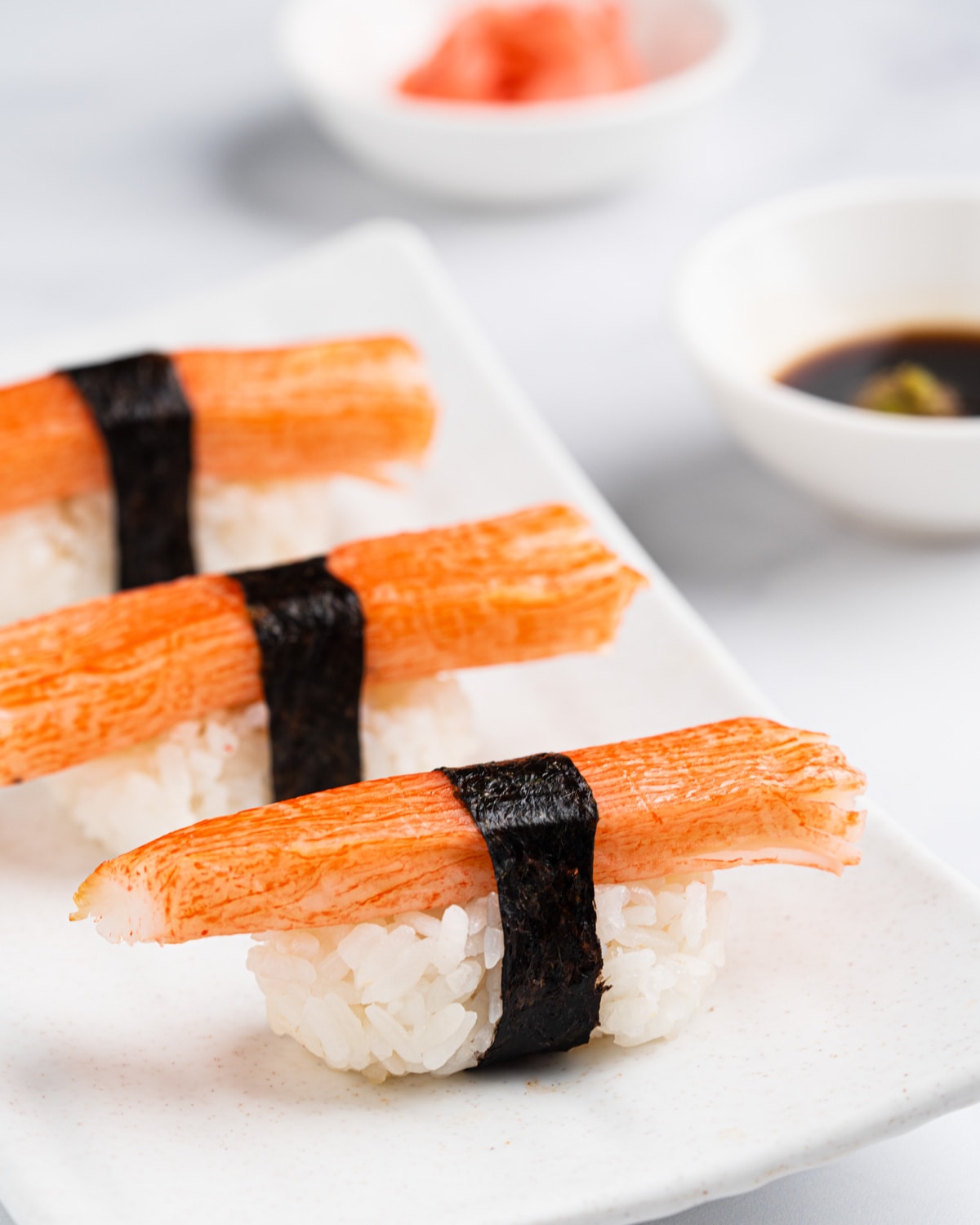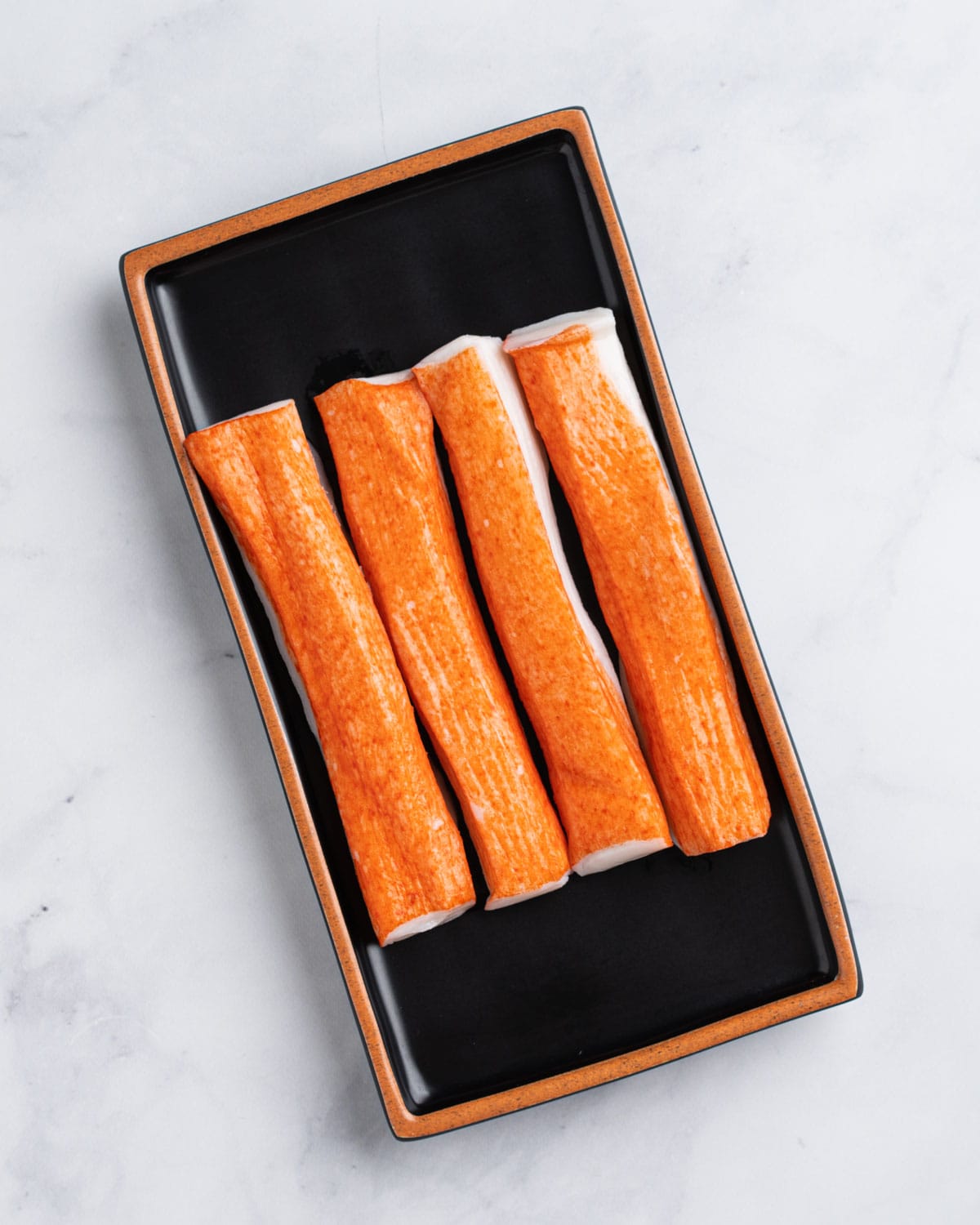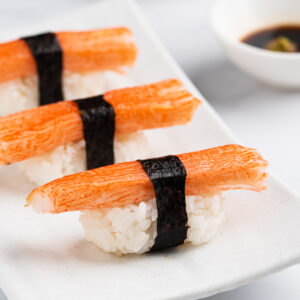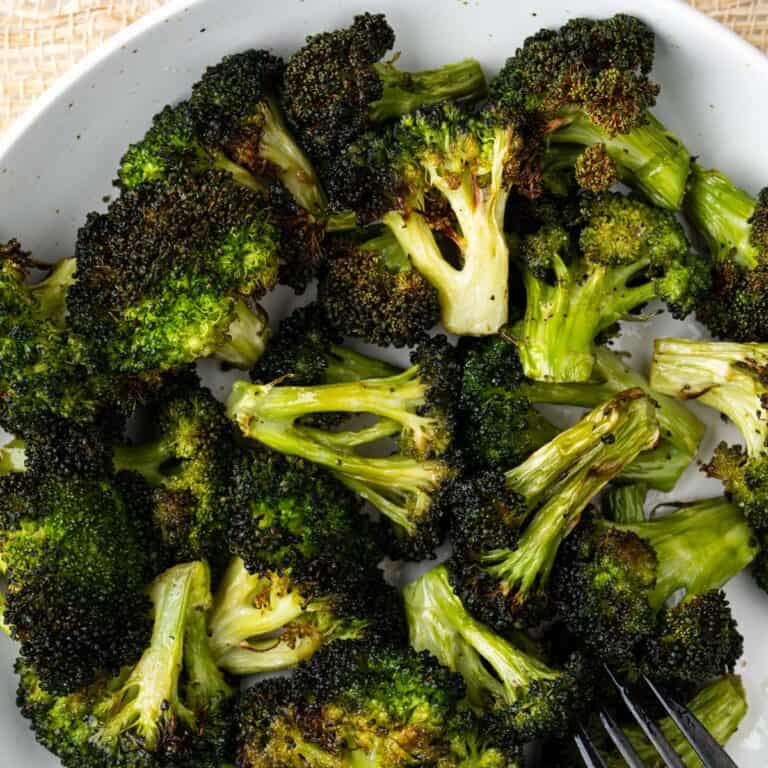What is Kanikama (imitation crab) | Kani Sushi Recipe
You’re at a charming Japanese restaurant, eager to explore the flavors of the cuisine when you come across the term “kanikama” on the menu. The name may sound intriguing, but what exactly is it? Scroll down to find out!
But why limit your experience to restaurants? The journey doesn’t end there. With this step-by-step guide, you’ll transform into a sushi expert in your own kitchen. Learn how to make your own kani sushi nigiri at home.

What is Kanikama (kani)?
Kanikama, also known as imitation crab meat or crab stick, is a type of processed seafood product that resembles the appearance and texture of crab meat. It is a popular ingredient used in various cuisines, particularly in Japanese and Asian dishes. Despite its name, kanikama does not contain any real crab meat.

The main ingredient in kanikama is usually surimi, which is a paste made from pulverized fish meat, typically from white fish like pollock, hake, or whiting. The surimi is mixed with other additives such as starch, egg whites, salt, and flavorings to mimic the taste, texture, and color of crab meat. After being processed and shaped into sticks or flakes, kanikama is usually cooked and then packaged for sale.
Kanikama is often used in sushi rolls, salads, seafood salads, and various other dishes. It offers a more affordable and widely available alternative to real crab meat, making it a popular choice in many recipes, especially those requiring a crab-like texture and flavor.
Where to buy kani?
Here are some common locations where you can find it:
- Grocery stores: Most well-stocked grocery stores, supermarkets, and Asian grocery stores carry kanikama in their seafood or frozen food sections.
- Seafood markets: Local seafood markets often sell kanikama along with other seafood products.
- Online retailers: You can find kanikama on popular online shopping platforms such as Amazon, Walmart, and other food delivery websites.
- Asian markets: Asian markets or stores that specialize in Japanese or Asian products are likely to have kanikama in their seafood section.
- Sushi restaurants or sushi bars: Some sushi restaurants may also sell packaged kanikama for customers who want to make sushi at home or include it in their own recipes.
What does it taste like?
Kanikama, or imitation crab meat, is designed to mimic the taste of real crab meat, but it does have some distinct differences in flavor. The taste of kanikama can vary slightly depending on the brand and the specific additives used, but here are some general characteristics of its flavor:
- Sweetness: Kanikama has a mild sweetness similar to that of real crab meat. This sweetness helps to emulate the taste of crab.
- Slight fishy flavor: Since the main ingredient in kanikama is surimi, which is made from fish, it can have a subtle fishy taste. However, this fishy flavor is usually quite mild compared to actual seafood.
- Umami: Kanikama often contains additives and flavorings that enhance the umami taste, contributing to its overall savory flavor profile.
- Saltiness: Like many processed seafood products, kanikama is seasoned with salt to enhance its taste.
Overall, the taste of kanikama is pleasant, and when used in dishes like sushi rolls, salads, or crab cakes, it can provide a satisfying crab-like flavor without the cost and availability concerns associated with real crab meat. However, it’s important to note that the taste of kanikama may not be an exact replica of real crab meat, and some people may prefer the unique taste of authentic crab over the imitation version.
Ingredients for kani sushi

- Kanikama (imitation crab): Choose high-quality Kani with natural ingredients for authentic flavor. Visit reputable Asian grocery stores or supermarkets with seafood sections to buy fresh Kanikama.
- Sushi Rice: Opt for premium sushi rice like short-grain Japanese varieties for perfect texture and flavor. Find it at well-stocked Asian markets or online retailers specializing in Japanese ingredients.
- Rice Vinegar: Rice vinegar is added to sushi rice to enhance its flavor, add a touch of tanginess, and create the characteristic stickiness that holds sushi together, making it easier to shape and eat.
- Sugar: For flavoring the rice with a touch of sweetness.
- Salt: To enhance the flavor of the rice and topping.
- Nori: Thin strips of nori seaweed are used in nigiri to provide a subtle contrast in texture and flavor. They add a delicate hint of seaweed taste and visual appeal to the sushi.
- For Serving (optional): soy sauce, wasabi, and pickled ginger.
Please scroll ⬇️ to the recipe card to see the full ingredient amounts and instructions.
How to make it

Step One: Prepare Sushi Rice. Cook sushi rice according to package instructions. While the rice is still warm, gently mix in a mixture of rice vinegar, sugar, and salt. Allow the rice to cool to room temperature.
Step Two: Shape the Nigiri. Wet your hands with a mixture of water and rice vinegar to prevent the rice from sticking. Take a small amount of sushi rice and gently shape it into an oblong mound, about the size of your index finger.
Step Three: Prepare the Kani. Unwrap the kani sticks and separate them into individual strands. Gently drape a strand of kani over the formed rice mound.
Step Four: Add Nori Strip. Place a thin strip of nori over the kani.
Serve and Enjoy! Arrange the kani nigiri on a serving plate.
Tips for the best kani sushi
- Select fresh kanikama and other ingredients for your sushi rolls. Freshness contributes significantly to the overall taste and texture of your sushi.
- Prepare the sushi rice properly with the right balance of vinegar, sugar, and salt. The rice should be sticky but not mushy.
- Consistent rice mounds: When shaping the rice for nigiri, make sure each mound is consistent in size and shape. Wet your hands with a mixture of water and rice vinegar to prevent the rice from sticking to your hands.
- Proper rice proportions: The rice should form a compact base for the topping. Aim for a ratio of around 1:1 rice to topping, but adjust this based on the size and type of topping.
- Gently form the nigiri: Press the topping onto the rice with a gentle touch. The topping should adhere to the rice without squashing it.

How to store leftovers
- Wrap it tightly: Take the leftover kani sushi rolls and wrap them tightly in plastic wrap or aluminum foil. Ensure there is no exposure to air, as it can cause the rice to dry out and affect the taste and texture.
- Refrigerate promptly: If your kani sushi has been sitting at room temperature, it’s essential to cool it down quickly to prevent bacterial growth. Ideally, refrigerate the leftovers within two hours of making them. Place the wrapped sushi rolls in an airtight container or a resealable plastic bag, and store them in the refrigerator.
- Consume within 24 hours: Sushi tastes best when it’s fresh, so try to consume the leftover kani sushi within 24 hours of refrigeration.
- Don’t freeze it: While you can freeze some types of sushi, it’s not recommended for kani sushi. The texture of the imitation crab and rice can be adversely affected by freezing and thawing.
- Reheat with caution (optional): Sushi is typically enjoyed cold, but if you prefer warm sushi, you can reheat it slightly. Place the wrapped sushi in the microwave for a few seconds or lightly toast it in a toaster oven. Be careful not to overheat it to avoid making the rice too mushy.
More Recipes with Kanikama
- Sushi Bake
- Spicy Kani Salad
- California Roll
RECIPE

Kani Sushi (Kanikama Nigiri)
Ingredients
- 4 fresh Kani (imitation crab) sticks (cut in half)
- 2 cups cooked sushi rice
- 2 tablespoons rice vinegar
- 1 tablespoon sugar
- 1 teaspoon salt
- 1 nori sheet (cut into thin ½ inch strips)
For Serving (optional)
- soy sauce
- wasabi
- pickled ginger
Instructions
- Prepare Sushi Rice. Cook sushi rice according to package instructions. While the rice is still warm, gently mix in a mixture of rice vinegar, sugar, and salt. Allow the rice to cool to room temperature.
- Shape the Nigiri. Wet your hands with a mixture of water and rice vinegar to prevent the rice from sticking. Take a small amount of sushi rice and gently shape it into an oblong mound, about the size of your index finger.
- Prepare the Kani. Unwrap the kani sticks and separate them into individual strands. Gently drape a strand of kani over the formed rice mound.
- Add Nori Strip. Place a thin strip of nori over the kani and rice.
- Serve and Enjoy! Arrange the kani nigiri on a serving plate.







This is such a helpful guide to preparing sushi from scratch at home!! I’ve always been intimidated by making homemade sushi but you’ve inspired me to try it out!
This was such a unique and unexpected recipe that does not disappoint! Exactly what I needed to get my sushi fix; definitely a new favorite recipe!
Kani is one of my favorite things to order whenever I get sushi! I never even considered that it might be this easy to make nigiri at home, can’t wait to try it for myself!
I really enjoyed this dish and it was easy to make! I can’t wait to make it for our next dinner party.
Thanks! I always wondered what kanikama was!